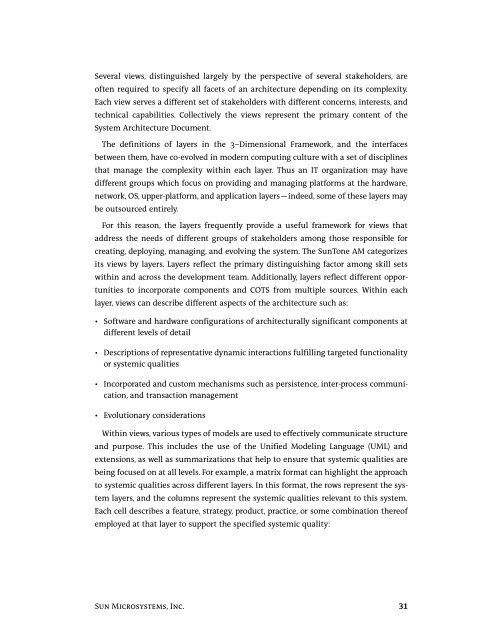SUNTONE ARCHITECTURE METHODOLOGY A 3-DIMENSIONAL ...
SUNTONE ARCHITECTURE METHODOLOGY A 3-DIMENSIONAL ...
SUNTONE ARCHITECTURE METHODOLOGY A 3-DIMENSIONAL ...
You also want an ePaper? Increase the reach of your titles
YUMPU automatically turns print PDFs into web optimized ePapers that Google loves.
Several views, distinguished largely by the perspective of several stakeholders, are<br />
often required to specify all facets of an architecture depending on its complexity.<br />
Each view serves a different set of stakeholders with different concerns, interests, and<br />
technical capabilities. Collectively the views represent the primary content of the<br />
System Architecture Document.<br />
The definitions of layers in the 3–Dimensional Framework, and the interfaces<br />
between them, have co-evolved in modern computing culture with a set of disciplines<br />
that manage the complexity within each layer. Thus an IT organization may have<br />
different groups which focus on providing and managing platforms at the hardware,<br />
network, OS, upper-platform, and application layers—indeed, some of these layers may<br />
be outsourced entirely.<br />
For this reason, the layers frequently provide a useful framework for views that<br />
address the needs of different groups of stakeholders among those responsible for<br />
creating, deploying, managing, and evolving the system. The SunTone AM categorizes<br />
its views by layers. Layers reflect the primary distinguishing factor among skill sets<br />
within and across the development team. Additionally, layers reflect different opportunities<br />
to incorporate components and COTS from multiple sources. Within each<br />
layer, views can describe different aspects of the architecture such as:<br />
• Software and hardware configurations of architecturally significant components at<br />
different levels of detail<br />
• Descriptions of representative dynamic interactions fulfilling targeted functionality<br />
or systemic qualities<br />
• Incorporated and custom mechanisms such as persistence, inter-process communication,<br />
and transaction management<br />
• Evolutionary considerations<br />
Within views, various types of models are used to effectively communicate structure<br />
and purpose. This includes the use of the Unified Modeling Language (UML) and<br />
extensions, as well as summarizations that help to ensure that systemic qualities are<br />
being focused on at all levels. For example, a matrix format can highlight the approach<br />
to systemic qualities across different layers. In this format, the rows represent the system<br />
layers, and the columns represent the systemic qualities relevant to this system.<br />
Each cell describes a feature, strategy, product, practice, or some combination thereof<br />
employed at that layer to support the specified systemic quality:<br />
Sun Microsystems, Inc.<br />
31


